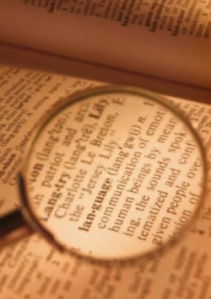Wordplay is a regular column by editor and language writer James Harbeck in which he tastes and plays with English words and usages.
The King James Version of the Bible gives us two English words that usually travel together: jot and tittle. We find them in Matthew 5:18: “For verily I say unto you, Till heaven and earth pass, one jot or one tittle shall in no wise pass from the law, till all be fulfilled.”
These are two titillating words worth jotting down, especially if you’re the type type. Jot is an English rendition of the Greek iota, ἰῶτα, as in “not one iota of sense.” Iota, as I think you know, is the name of the smallest letter in the Greek alphabet: ι. But the law of which Jesus was speaking in the quote was not written in Greek. It was  written in Hebrew. The smallest letter in Hebrew is called yod, and looks like the image on the left.
written in Hebrew. The smallest letter in Hebrew is called yod, and looks like the image on the left.
Yod, iota: is the similarity of name a coincidence? Of course not; they’re both descended from the Phoenician letter yodh, which, in turn, was probably descended from a picture of a hand. The Greek iota became the Latin I, which, in turn, over the centuries split into two letters, i and j. (Just incidentally, in German j is called jot, and in Spanish and Portuguese it’s jota, all from iota.) The dot on top appeared in the medieval era to make it stand out among all the other vertical strokes in the calligraphy, so you could more easily read, for instance, minimi (“the smallest”).
That dot, now. What’s another name for the dot on the i and j—or for any other similar minimal distinguishing mark in lettering? Tittle, which comes from Latin titulus, which originally meant “inscription” or “heading” (whence title). Yes, “not one i or one dot on an i”—except that, of course, the dots didn’t exist in the original text of the law. But Hebrew letters have small distinguishing strokes, and there are diacritics for vowels.
But what word does the Greek source have where we have tittle (or, in more recent translations, stroke of a letter)? It’s keraia, κεραία (note that that’s an accent on the iota, not a dot). My Pocket Oxford Classical Greek Dictionary defines κεραία as “sail-yard; beam; pole; the apex of a letter; dot, tittle.” In modern Greek it means “antenna” (electronic or insect). But look again at apex: that’s the word that’s used in the Latin vulgate for the same thing—“iota unum aut unus apex non præteribit” etc. An apex is a peak, right? Yes, or a little point on top. A small thing sticking up, like a feeler.
Do you wonder how this passage is rendered into other languages? For the most part, the translations use words meaning “point” or “dot” or “stroke.” Some Italian versions use apice (from Latin apex), others punta (“point”). One German translation uses Häkchen, which means a little hook-stroke, like a Czech háček (which names the upside-down circumflex on the c there). Some translations into some languages just use an adopted and adapted version of titulus or tittle: Danish and Norwegian tøddel, Dutch tittel, German Tüttel, Ukrainian титла, Spanish tilde.
Tilde? As in that eyebrow that you see tiled on top of the n in pequeño (“small”)? Yes, that’s the one. The word tilde is what the Latin titulus became in Spanish. Not that Spanish invented the mark. It was used as diacritic showing intonation in Greek, as on the word ἰῶτα (yes, the Greek for jot has a tittle). Medieval Latin scribes used it to indicate predictable omitted letters (usually including n or m, often the suffix um). For example, cum was typically written c̃ (from which we get a common abbreviation for “with”); imperpetuum (“forever”) might be written ĩperpetũũ. From that the tilde came to stand for nasalization on Portuguese vowels (as in indicação, “indication”) and palatalization on a Spanish ñ (for example, pequeño, “small”). It also indicates nasalization in phonetic transcriptions.
We also use it as a separate character now for logical, mathematical, and scientific purposes. It has passed into common use from math to stand for “about,” and you could almost say on that basis it still stands for um: ~10:00 really means “um, 10:00?” You can also see the tilde as like the wavy gesture you can make with your hand to indicate “more or less,” as in “10:00, more or less.”
So we see: the stroke has not passed away. It has been with us, more or less (sometimes more and sometimes less) for millennia, jotted down by hand, changing meaning and shape, but here to stay imperpetuum: tilde end of time.
James Harbeck is a web editor, print designer, and trained linguist. Read his blog at sesquiotic.wordpress.com and articles at TheWeek.com.
This article was copy edited by Karen Palmer.

This is a delightful article.
LikeLike